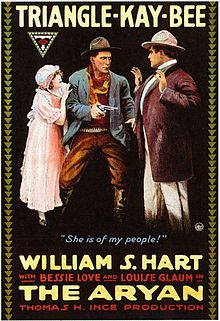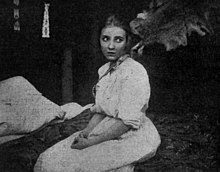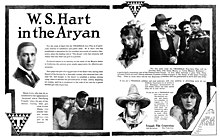| The Aryan | |
|---|---|
 Theatrical poster | |
| Directed by | William S. Hart Reginald Barker Clifford Smith |
| Written by | C. Gardner Sullivan |
| Produced by | Thomas H. Ince |
| Starring | William S. Hart Bessie Love Louise Glaum Charles K. French Gertrude Claire |
| Cinematography | Joseph H. August[1] |
Production company | |
Release date |
|
Running time | 50 minutes; 5 reels |
| Country | United States |
| Languages | Silent English intertitles |
| Budget | $13,500[2] |
The Aryan is a 1916 American silent Western film starring William S. Hart, Gertrude Claire, Charles K. French, Louise Glaum, and Bessie Love.[2]
Directed by William S. Hart and produced by Thomas H. Ince, the screenplay was written by C. Gardner Sullivan.
Although Hart was assisted by Reginald Barker and Clifford Smith, he mostly directed the film by himself. Hart's combined salary as actor and director was $150 per week (equivalent to $4,000 in 2023).[3]
A partial print of the film survives in the Library of Congress,[4][5] which was restored at the Museo del Cine Pablo Ducrós Hicken in Buenos Aires, Argentina.[5][6]
Plot[edit]

A hard working miner, Steve Denton (Hart), has become rich from years of prospecting. He takes his fortune and leaves to visit his ill mother, Mrs. Denton (Claire).
In the town of Yellow Ridge, however, he is detained by a seductive dance hall girl named Trixie (Glaum). Also known as "the firefly," Trixie not only cheats him out of his gold, but also conceals a message that was wired to him by his dying mother.
Learning the next day that his mother is dead, Denton is infuriated about being cheated and betrayed by Trixie, who pretended to be good, and other false friends. In his rage, he kills Trixie's lover, Chip Emmett (Mayall), and kidnaps her. Dragging her by the hair of her head, he takes her into the desert. Enslaving Trixie in his desert hideaway, Denton turns his back on "white civilization." He hates all white men and women and assumes the leadership of a band of Indian and Mexican bandits.
Two years later, a wagon train of Mississippi farmers who are lost and dying in the desert appeal to Denton for help. He refuses to assist them. He is secretly visited that night by Mary Jane Garth (Love), an innocent and virtuous young woman among the migrants who bravely confronts the Indians and Mexicans.
She pleads their cause and expresses her belief that no white man would refuse to protect a woman in distress. Deeply moved, Denton is redeemed. He guides the wagon train out of the desert and then resumes his wanderings.[7][8][9]
Cast[edit]
- William S. Hart as Steve Denton
- Gertrude Claire as Mrs. Denton
- Charles K. French as "Ivory" Wells
- Bessie Love as Mary Jane Garth
- Louise Glaum as Trixie, "the firefly"
- Herschel Mayall as Chip Emmett
- Ernest Swallow as Mexican Pete
- Enid Bennett
- Jean Hersholt
- John Gilbert as an extra (uncredited)
Cast notes[edit]
Hart made these observations on his role as Steve Benton:
I think the most disagreeable part I ever had was in The Aryan. It was hard for me to really feel it, being that of a white man, forswearing his race, makes outlaw Mexicans his comrades and allows white women to be attacked by them. It is difficult to put all one's decent instincts aside and live and think as such a despicable character must have done. But by allowing myself only to think of the terrible wrong that the white race had done me—pure imagery—I settled into it, and I am sure Bessie Love at the time believed I was the typical brute.
— "Living Your Character" in Motion Picture Magazine, May 1917[10]
Production[edit]
Hart was given a screenplay by the screenwriter C. Gardner Sullivan in which the hero had, according to Hart, "no motive for his hardness." He argued that the audience needed an explanation. Sullivan preferred the idea that his ruthless personality was simply a given, but eventually accepted Hart's wishes.[citation needed]
Although it was made during the silent era, Sullivan wrote long speeches for the actors to perform, which were filmed and later edited down.[11]

Hart wanted Mae Marsh for the role as Mary Jane, but Marsh was working on a D. W. Griffith movie at the time. Griffith recommended a new actress, Bessie Love.[12]
The movie was made at the height of Hart's career, but was unusual because he played a ruthless individual described as "hard as flint." As the title suggests, the movie draws on racial ideologies of the era. Hart stated that the central character, Steve Denton, was "a white man, who, foreswearing his race, makes outlaw Mexicans his comrades and allows white women to be attacked by them."[13]
The film was made at Inceville[14] and Sulphur Canyon.[11]
Reception[edit]

Contemporaneous reviews of the film were glowingly positive.[8][9] The photography, acting, and direction were all positively reviewed.[8][9] Hart himself believed this movie to be "one of the best Westerns ever made."[15]
However, later assessments of the film have been critical of its treatment of race. Of the film, Andrew Brodie Smith wrote, "Racism was not new to the western but it had never been articulated in such a sophisticated fashion."[16] Other scholars have labeled this as "perhaps the first film to openly proclaim the doctrine of White supremacy over Native American Indians".[17]
See also[edit]
References[edit]
- Citations
- ^ Love, Bessie (1977). From Hollywood with Love: An Autobiography of Bessie Love. London: Elm Tree Books. p. 148. OCLC 734075937.
- ^ a b Bennett, Carl (May 5, 2012). "Progressive Silent Film List: The Aryan". Silent Era.
- ^ Erickson, Hal. "The Aryan (1916)". AllMovie Guide. Retrieved December 20, 2014.
- ^ "[The Aryan—excerpts]". Library of Congress.
- ^ a b "Hallazgo y Restauración de "The Aryan"". Asociación de Amicos del Museo del Cine.
- ^ Rohter, Larry (May 4, 2010). "Footage Restored to Fritz Lang's Metropolis". The New York Times.
- ^ Johnston, Will H. (May 1916). "The Aryan". Picture-Play Magazine. Vol. 4, no. 3. pp. 234–245.
- ^ a b c Cooper, Oscar (April 8, 1916). "Screen Examinations". Motion Picture News. Vol. 13, no. 14. p. 2064.
- ^ a b c Harris, Genevieve (April 1, 1916). "Current Releases Reviewed". Motography. Vol. 15, no. 14. p. 766.
- ^ Koszarski 1976, pp. 47–48.
- ^ a b Love, Bessie (May 9, 1962). "An Aryan in Sulphur Canyon". The Christian Science Monitor. p. 8.
- ^ Hart, William (1929). My Life – East and West. Houghton Mifflin Company. p. 220.
- ^ Davis 2003, p. 84
- ^ "The Picture Oracle". Picture-Play Magazine. Vol. 5, no. 1. September 1916. p. 156.
- ^ Davis 2003, p. 83
- ^ Smith, Andrew Brodie (2003). Shooting Cowboys and Indians: Silent Western Films, American Culture, and the Birth of Hollywood. Boulder: University Press of Colorado. p. 166. ISBN 978-0-87081-746-5.
- ^ Wilson, Clint C. III; Gutierrez, Felix; Chao, Lena (2013). "'Bamboozling' Stereotypes Through the 20th Century". Racism, Sexism, and the Media: Multicultural Issues Into the New Communications Age. SAGE Publications. p. 69. ISBN 978-1-4522-1751-2.
- Works cited
- Davis, Ronald L. (2003). William S. Hart: Projecting the American West. University of Oklahoma Press. ISBN 978-0-8061-3558-8.
- Koszarski, Richard (1976). Hollywood Directors: 1914–1940. Oxford University Press. LCCN 76-9262.